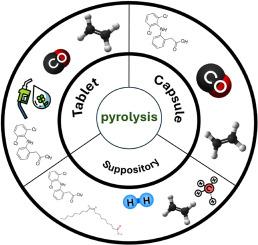双氯芬酸的热回收和赋形剂的热解增值
IF 5.8
2区 化学
Q2 CHEMISTRY, MULTIDISCIPLINARY
引用次数: 0
摘要
在本研究中,热解作为循环经济背景下的一种可持续的药物废物处理方法进行了研究。对四种不同的双氯芬酸钠药品制剂进行热解实验,包括两种抗胃片、一种胶囊和一种栓剂。用色谱法分析所得气体和液体。片剂和胶囊的热解液中含有大量的活性药物成分(API),相对丰度高达94.76%,由于配方中含有多种木质纤维素辅料,因此含有生物油中常见的酚类、酯类、酮类等化合物,产率高达32.93%。气体主要由高达79.77 mol%的CO组成,还有少量的CO2、H2、CH4和乙烯。该栓剂的产液率高达79.73%,其组成与脂肪物质热解产物相似,含有酸、酯、长链烷烃和烯烃,气体中富含H2、CH4和乙烯。利用DSC数据对各配方热解过程进行能量平衡。所有产品的净能量输出均为正,其中胶囊形式的净能量最高,为+14,566.77 J/g。研究结果强调了热解回收高价值原料药和产生富含能量的副产品的潜力,以支持该过程的整体可持续性。本文章由计算机程序翻译,如有差异,请以英文原文为准。

Thermal recovery of diclofenac and valorization of excipients via pyrolysis
In this study, pyrolysis is investigated as a sustainable waste treatment method for pharmaceuticals within the context of the circular economy. Pyrolysis experiments were conducted on four different diclofenac sodium drug product formulations, including two gastro-resistant tablets, one capsule, and one suppository. The resultant gases and liquids were analyzed by chromatography. The pyrolysis liquids of the tablets and capsules, with liquid yields up to 32.93 %, contained large amounts of the active pharmaceutical ingredient (API) itself, with relative abundance values up to 94.76 %, as well as compounds typically found in bio-oil, such as phenols, esters, and ketones, owing to multiple lignocellulosic-based excipients in the formulations. Gases consisted mostly of CO up to 79.77 mol%, with smaller quantities of CO2, H2, CH4, and ethylene. The suppositories produced a high liquid yield of 79.73 % with composition similar to those resultants from pyrolysis of fatty materials, containing acids, esters, and long-chain alkanes and alkenes, and gases rich in H2, CH4, and ethylene. DSC data was used to conduct an energy balance during the pyrolysis of each formulation. All products gave a net positive energy output with the capsule form producing the highest net energy of +14,566.77 J/g. The findings highlight the potential of pyrolysis to recover high-value APIs and generate energy-rich byproducts to support the overall sustainability of the process.
求助全文
通过发布文献求助,成功后即可免费获取论文全文。
去求助
来源期刊

Sustainable Chemistry and Pharmacy
Environmental Science-Pollution
CiteScore
8.20
自引率
6.70%
发文量
274
审稿时长
37 days
期刊介绍:
Sustainable Chemistry and Pharmacy publishes research that is related to chemistry, pharmacy and sustainability science in a forward oriented manner. It provides a unique forum for the publication of innovative research on the intersection and overlap of chemistry and pharmacy on the one hand and sustainability on the other hand. This includes contributions related to increasing sustainability of chemistry and pharmaceutical science and industries itself as well as their products in relation to the contribution of these to sustainability itself. As an interdisciplinary and transdisciplinary journal it addresses all sustainability related issues along the life cycle of chemical and pharmaceutical products form resource related topics until the end of life of products. This includes not only natural science based approaches and issues but also from humanities, social science and economics as far as they are dealing with sustainability related to chemistry and pharmacy. Sustainable Chemistry and Pharmacy aims at bridging between disciplines as well as developing and developed countries.
 求助内容:
求助内容: 应助结果提醒方式:
应助结果提醒方式:


